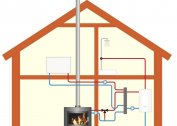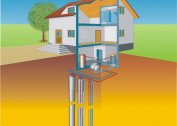Over the past few years, the issue of housing heating has become particularly acute. The reason for this was the frequent interruptions in the central heating of high-rise buildings, rising gas prices and the provision of heat to private cottages. Not surprisingly, people began to look for alternative ways to heat their homes. One of the best solutions turned out to be the installation of a warm floor. Even in the case of powerful radiators, the air warms up not as high quality as with a warm floor. In the presence of underfloor heating, the heated air begins to rise from the bottom up, providing uniform heating of the room. This technology is only beginning to be in demand in the CIS countries, and in Europe it is already found in most modern homes. Next, you can find out about all the advantages of a warm floor, methods and relevance of its installation.
Advantages of installing a warm floor
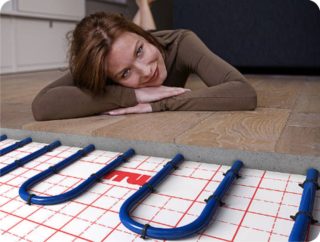 Many residents of apartment buildings complain of insufficient heating of their premises. Some are saved by additional devices in the form of electric heaters, while someone is looking for alternatives. If you think that only radiators are able to heat your apartment with high quality, then you are mistaken. The warm floor will cope with this task many times better.
Many residents of apartment buildings complain of insufficient heating of their premises. Some are saved by additional devices in the form of electric heaters, while someone is looking for alternatives. If you think that only radiators are able to heat your apartment with high quality, then you are mistaken. The warm floor will cope with this task many times better.
The unpopularity of this type of heating in the CIS countries is associated, rather, with people's fear of changing habitual stereotypes, rather than lack of financial opportunities. Not every person believes that in the conditions of winter frosts it is possible to heat a house using such technology. In fact, it is worth recognizing that underfloor heating is an extremely effective and advanced solution for heating residential premises. The advantages of this system have been confirmed by almost all European countries, and in Norway about 80% of buildings are equipped with floor heating.
Compared to radiator heating, floor heating has a number of advantages:
- uniform and operational heating of the room;
- admissibility of installation both in multi-apartment buildings and in private houses;
- the ability to adjust the temperature of each room and turn off the system in the event of a trip or a long absence from home;
- possibility of use as an auxiliary heat source;
- admissibility of installation in both residential and office buildings;
- safety of use with almost all types of flooring;
- ease of installation;
- improving the interior and increasing free space due to the lack of radiators and other elements of central heating;
- reliability and long-term operation.
Particularly enjoyable use of the floor will seem to those who like to walk around the house with bare feet. And mothers of young children can no longer worry about the fact that their child will catch a cold while walking around the apartment.
Tile underfloor installation
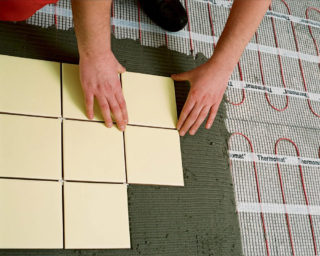 Most often, the installation of a floor heating system for tiles is carried out in apartments, where the installation of water floors is not possible. Usually this difficulty arises in the bathroom or in the kitchen, where, as a rule, cold plates lie. The system will help solve the problem of cold floors, and will be especially useful for those who have small children and pets at home. Today, floor heating in the kitchen and bathroom is already a standard situation. However, some lovers of warmth and comfort have taken care of the loggia, on which the warm floor will be no less relevant.
Most often, the installation of a floor heating system for tiles is carried out in apartments, where the installation of water floors is not possible. Usually this difficulty arises in the bathroom or in the kitchen, where, as a rule, cold plates lie. The system will help solve the problem of cold floors, and will be especially useful for those who have small children and pets at home. Today, floor heating in the kitchen and bathroom is already a standard situation. However, some lovers of warmth and comfort have taken care of the loggia, on which the warm floor will be no less relevant.
At the moment, installing the system under the tile is carried out in the following ways:
- the heating element is laid in a screed, and then any coating is laid on the floor in the usual way;
- first, the screed is made, and only then the heating elements are laid between the plates and the screed itself;
- the floor heating system is completely mounted under the laid floor covering. However, this method is most relevant in the case of installation of structures made of film.
The first installation method is advisable if the system is installed in living rooms or a bathroom. In this situation, a cable heating system is purchased, which is laid under the tile. Installation should be made on a layer of waterproofing material, on top of which there is a screed. If we are talking about an apartment building, where most often neighbors live under you, then screed and additional layers of thermal insulation are not required. The system is laid directly under the tile, and is poured with a layer of a special gel that insulates the heating elements.
Natural wood floor or laminate
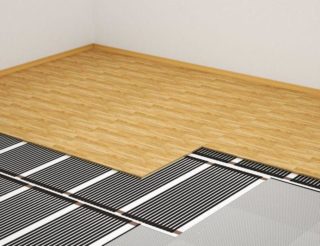 Wooden floors are also very popular today. And so the question of the possibility of using underfloor heating with a laminate was not long in coming.
Wooden floors are also very popular today. And so the question of the possibility of using underfloor heating with a laminate was not long in coming.
If you decide to install a warm floor under the laminate, then during installation you should use a film heating element. The infrared floor makes it possible to lay on the existing screed, which does not confuse the owner with additional repair work. The system is installed on top of the insulation, and then covered with a layer of waterproofing and, as a result, the wooden coating itself. If you follow all the instructions for installing and using the system with a wooden floor, then you should not worry about security.
Laying underfloor heating: what costs should be expected
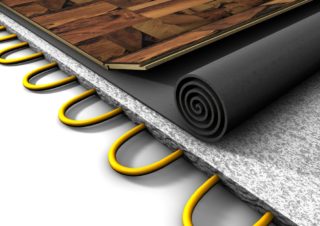 As practice shows, the cost of installing and operating a warm floor does not bite at all. Naturally, the use will require additional costs in the form of payment of electricity bills. However, your expenses in the case of operation of this system will be more rational.
As practice shows, the cost of installing and operating a warm floor does not bite at all. Naturally, the use will require additional costs in the form of payment of electricity bills. However, your expenses in the case of operation of this system will be more rational.
The amount of energy consumed during the operation of the system will vary due to the following factors:
- weather;
- room area and number of heated rooms;
- type of flooring;
- the quality of thermal insulation of rooms;
- frequency of use;
- mode of application.
In accordance with the statistics obtained, on average, consumption values fluctuate around 160-205 W / m2 in the case of the main heating source, and 105-160 W / m2 in the case of the additional source.
